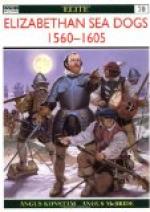After Master Cabota and divers gentlemen and gentlewomen had viewed our pinnace, and tasted of such cheer as we could make them aboard, they went on shore, giving to our mariners right liberal rewards; and the good old Gentleman, Master Cabota, gave to the poor most liberal alms, wishing them to pray for the good fortune and prosperous success of the Serchthrift, our pinnace. And then, at the sign of the Christopher, he and his friends banqueted, and made me and them that were in the company great cheer; and for very joy that he had to see the towardness of our intended discovery he entered into the dance himself, amongst the rest of the young and lusty company—which being ended, he and his friends departed, most gently commending us to the governance of Almighty God.
CHAPTER II
HENRY VIII, KING OF THE ENGLISH SEA
The leading pioneers in the Age of Discovery were sons of Italy, Spain, and Portugal.[2] Cabot, as we have seen, was an Italian, though he sailed for the English Crown and had an English crew. Columbus, too, was an Italian, though in the service of the Spanish Crown. It was the Portuguese Vasco da Gama who in the very year of John Cabot’s second voyage (1498) found the great sea route to India by way of the Cape of Good Hope. Two years later the Cortereals, also Portuguese, began exploring the coasts of America as far northwest as Labrador. Twenty years later again the Portuguese Magellan, sailing for the King of Spain, discovered the strait still known by his name, passed through it into the Pacific, and reached the Philippines. There he was killed. But one of his ships went on to make the first circumnavigation of the globe, a feat which redounded to the glory of both Spain and Portugal. Meanwhile, in 1513, the Spaniard Balboa had crossed the Isthmus of Panama and waded into the Pacific, sword in hand, to claim it for his king. Then came the Spanish explorers—Ponce de Leon, De Soto, Coronado, and many more—and later on the conquerors and founders of New Spain—Cortes, Pizarro, and their successors.
[2: Basque fishermen and whalers apparently forestalled Jacques Cartier’s discovery of the St. Lawrence in 1535; perhaps they knew the mainland of America before John Cabot in 1497. But they left no written records; and neither founded an oversea dominion nor gave rights of discovery to their own or any other race.]
During all this time neither France nor England made any lodgment in America, though both sent out a number of expeditions, both fished on the cod banks of Newfoundland, and each had already marked out her own ‘sphere of influence.’ The Portuguese were in Brazil; the Spaniards, in South and Central America. England, by right of the Bristol voyages, claimed the eastern coasts of the United States and Canada; France, in virtue of Cartier’s discovery, the region of the St. Lawrence. But, while New Spain and New Portugal flourished in the sixteenth century, New France and New England were yet to rise.




